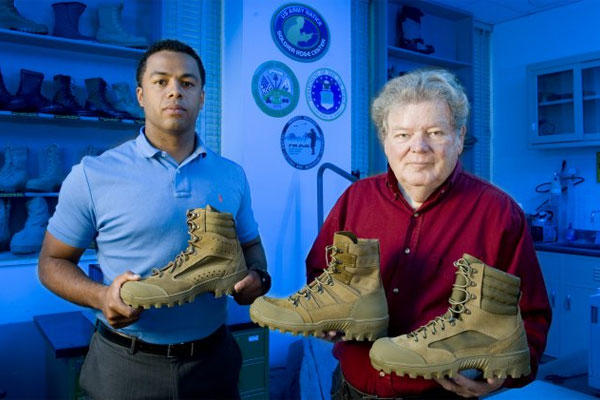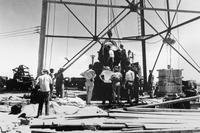NATICK, Mass. – What it all comes down to is keeping soldiers' minds on their missions in Afghanistan, rather than on their feet.
That's how Ben Cooper views the development of the Hot Weather Mountain Combat Boot, at the U.S. Army’s Natick Soldier Research, Development and Engineering Center here.
Development of the new boot began in early 2011, and Cooper thought it was so important that he got permission to continue working on the boot after leaving the Footwear Performance Laboratory to become a senior materials engineer for the Air Force, still located at Natick.
"Ben was so involved in the early phases of this and had been really running this project superbly, I thought that it was a good idea that he was able to continue on this project," said Bob Hall, the current Army footwear engineer for the boot.
"Obviously, in these fiscal times, being able to join together and work toward a common goal for the warfighter and for our country, I think, is the most important thing," Cooper said. "My supervisors have been very supportive about me taking time to help out and support the Army with this effort, and we're all happy to do it.
"The Air Force has been a team player in this," he continued. "It's a sister service -- one team, one fight."
Cooper and Hall are working with Program Executive Office Soldier and Product Manager Soldier Clothing and Individual Equipment to unveil phase two of the boot. Phase one -- a lighter, more breathable version of the popular Mountain Combat Boot -- has been issued to every soldier deploying to Afghanistan for the past year. As many as 200,000 pairs of the boots have been fielded with great success.
"[For] the amount of boots that are out there, we've had very, very few complaints," Hall said.
"Soldiers will give you honest feedback," Cooper said. "We haven't heard bad things. In this business, silence is a great thing."
Cooper pointed out that nothing like the HWMCB existed before soldiers in Afghanistan began asking for it two years ago.
"We were trying to develop and identify the salient characteristics of a Hot Weather Mountain Combat Boot," Cooper said. "Since it was a new item, it's not commercially available. We evaluated three different material solutions at that time from three different manufacturers."
Using soldier feedback from phase one, which included requests for more breathability, Cooper and Hall confidently strode into phase two.
"We cherry-picked the very best features on each of the boots, and we provided that feedback to industry," Cooper said. "They responded and provided new solutions, updated solutions."
Three new styles are now being evaluated at the National Training Center, Fort Irwin, Calif., by units from the 2nd Brigade Combat Team, 4th Infantry Division, based at Fort Carson, Colo. Each boot is nearly a half-pound lighter than the original mountain boot.
"Due to Afghanistan's unique climate and environment, they needed a boot that not only would provide them ankle stability and traction and durability, but they also needed greater breathability," Cooper said. "It's a balancing act. We were constantly walking that fine line. I think that we have worked with industry tirelessly on trying to make sure that we accomplish exactly what the warfighter wants and needs."
Industry made the boots more breathable by including moisture-wicking linings, perforating the leather, and inserting textiles wherever possible between the leather and rubber, without compromising stability.
"It took some creative approaches to be able to do that," Cooper said. "If you're kicking rocks, and you're crawling, and you're in the prone position, you need to be able to not have this thing rip."
Cooper will travel to Fort Irwin at the end of June with Chris King, of the Operational Forces Interface Group at Natick, to collect data from soldiers on the 285 pairs of boots that had been issued to them.
"We're going to go meet them as soon as they get out of the box at NTC," Cooper said. "I think the phase one boots were fairly well received. We would expect to find more positive feedback. We're hopeful that we're going in the right direction."
The goal is a technical specification for a boot that could be supplied by any manufacturer. When it's achieved, it will be because of the collaborative atmosphere at Natick, Cooper said.
"I can walk down the hall and speak with the foremost expert in [fire-resistant] clothing and apparel," he said. "I can walk down the other end of the hall and talk to the foremost expert in cold-weather equipment, in mountaineering gear, in footwear.
"I think that's just part of the culture that is here, and I'm proud to be a part of that," Cooper continued. "We were able to leverage all the resources that we have available to us."



























